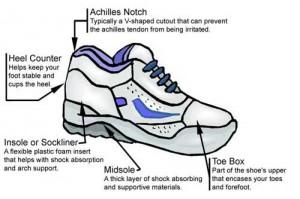Walking and running are a popular form of exercise for many. Trekking is becoming a favorite past time and Running is gaining popularity, with increasing number of mini, half and full marathons happening in our city and so are running injuries. What matters is, are we wearing the right kind of foot wear? Improper foot wear can lead to a lot of Lower body injuries and increased stress on the spine. We see a lot of Increase in the Heel pain, foot, ankle and shin in recent times. Most times caused by improper foot wear. The common foot problems caused by improper foot wear include Calluses, Corns, Plantar fasciitis, heel spur(heel Pain), metatarsalgia (fore foot pain), Tendinitis of the foot muscles, ankle pain, pain in the top of the foot, pain in the lower leg, calf pain, stress fractures of the leg and foot, knee pain etc., There is a lot of misconception, when it comes to picking up the shoe. Some say they pickedup the most expensive shoe, some say it’s a light weight shoe, five finger Vibram, glute toners, rocker bottom and other fancy names to sell the shoes. But what is important is to pick up the right shoe for your foot!!!
Foot Types:
Normal foot : Absorbs Shock well, Well supported with Muscles and has a good alignment of bones. In the pronated(flat foot) and Supinated (High Arch) foot, there is a muscle imbalance and there is improper alignment of the bones and joints leading to improper bio mechanics there by adding stress to the lower limb.
How to choose the right foot wear:
The first step in finding an appropriate shoe is to determine your foot type. The key is to recognize how the foot functions when it’s in motion; however, thinking of the footsteps you leave walking on a sandy beach can be helpful. The over-pronator will leave a full impression of the foot while the under-pronator will leave
only a crescent shape impression with much of the arch missing. Running shoe companies make shoes for the three foot types discussed above.
1.Make sure the shoes have good cushioning, Remember, Only sprinters wear light weight shoes, so do not look for light weight shoes, which most times doesn’t have enough cushioning to absorb the shock.
2. Make sure the mid portion/waist is nice and broad at the bottom if you have a flat foot and the insole/sock liner has an arch support in the inside of the shoe.
3. The shoe should not be too flexible nor too rigid, ideally you don’t want the fore foot of the a shoe to touch the heel pad when you fold. Half way to three fourth would just be fine.
4. Make sure the heel counter is rigid and holds your ankle. Also check if the shoe has adequate Achilles tendon padding.
5. Make sure the toe box is wide and the tongue of the shoe has enough padding.
6. The sole of the foot also is important. If you are going to do a lot of trekking/slippery surface then shoes with rubber studs/cleats will help.
7. Remember to pick up your shoes in the evening change your shoes every 500kms.,those who are diabetics, should consult their physician before picking up the shoes and should inspect their foot quite often and follow good foot care practices as poor circulation and impaired sensation might have caused blisters and infections.
